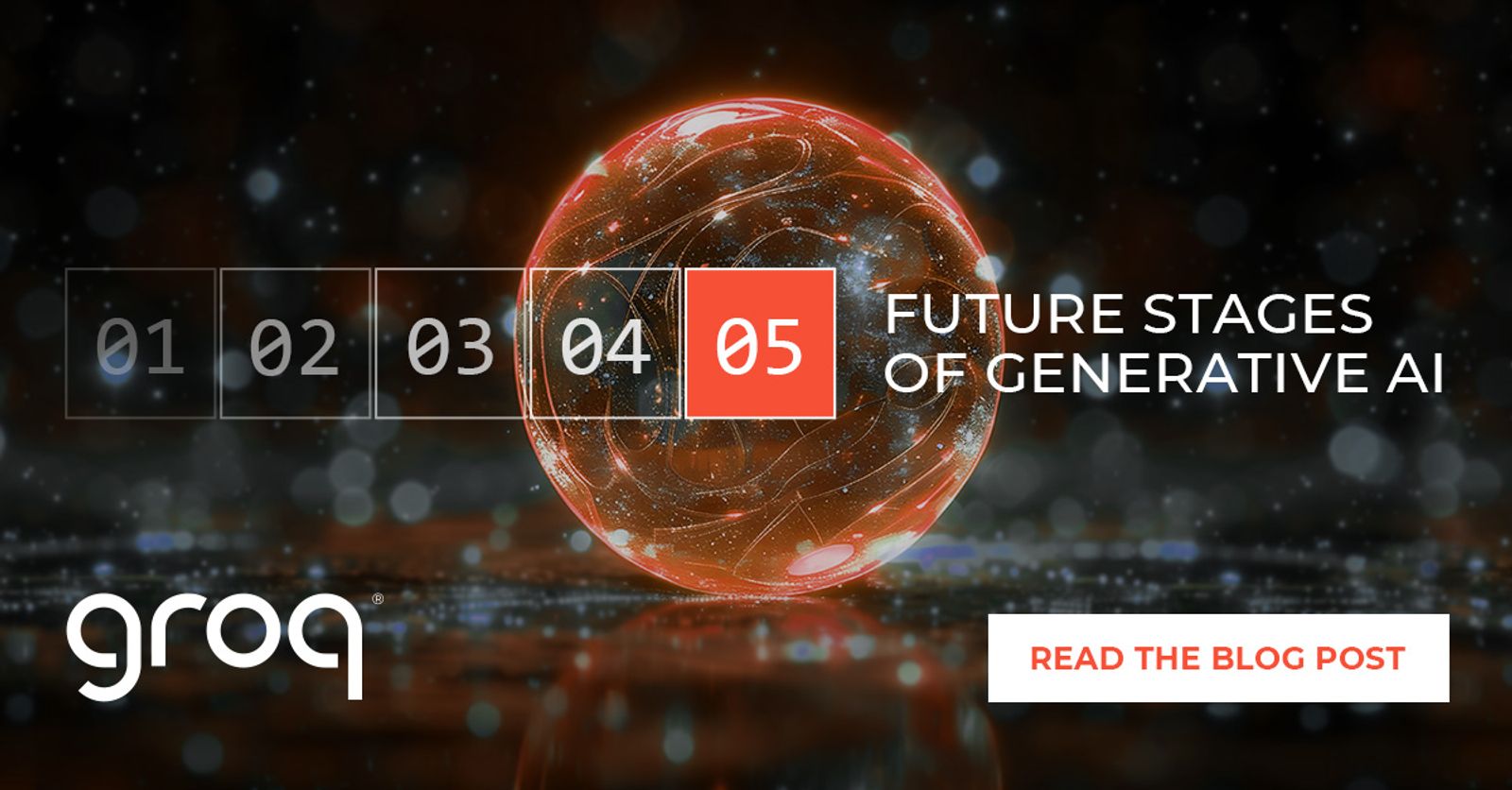
The Five Future Stages of Generative AI
This blog is adapted from an original post by Groq CEO and Founder, Jonathan Ross.
If Large Language Models (LLMs) are the printing press of the Generative AI age, then what’s next? What will be the AI equivalent of the telephone, the internet, the smartphone?
Today, looking at the progression of LLMs, we can begin speculating about when we will achieve Artificial General Intelligence (AGI), whereby AI systems can understand, learn, think, and reason at a human-level. But that’s like expecting to build the likes of LinkedIn or Facebook on the back of a printing press. Every technological age has substages, each of which takes time to mature. For example, the first mobile devices – portable radios – came onto the market in the 1950s and cellular car phones were introduced in the 1980s, but smartphones didn’t come along until the 2000s and didn’t become ubiquitous for another decade after that.
What are those equivalent stages for Gen AI, the five future stages that will eventually lead to AGI? Here’s what we think:
Stage 1: LUI – Language User Interface (Today)
Instead of using keyboards, clicks, and pointing devices like mice and trackpads, how about we simply converse with our computers? Speech recognition-based user interfaces have been around for decades - e.g. interactive voice response systems fronting customer service phone lines - but those solutions are generally limited to a specific set of prompts.
LLMs have proven to be highly capable at bridging language to a set of actions. They are getting very good at not just understanding the words of what someone is saying, but also the meaning and intent. LUI solutions are already becoming mainstream.
The success of these solutions can be measured by how often they are successful in correctly converting requests into action, and how efficient it is for experts and power users to use them. The challenge is that there is always ambiguity in a request. More context in the prompt will make it easier for the AI to correctly infer the user intent.
Stage 2: Inform
In the “Inform” stage of Gen AI progression, AI systems will help people with guided search, verifying both human and AI-generated work, and generating reports. It will support people in accessing, understanding, and reporting true information about a particular topic. This requires models to be able to recognize the correctness of inputs and their own outputs. LLMs do this today, but only primitively; they will get better at detecting and reacting to anomalies.
Success can be measured as how well a solution handles errors and anomalies in data and outputs. The challenge is that what is “right” often isn’t binary or clear. The expectation will be for AI solutions to be better than humans at getting “right” right.
Stage 3: Agent
In the “Agent” stage of Gen AI progression, systems will support people in performing complicated but routine tasks. They will understand how to break down user requests into multiple, smaller subtasks. They will execute those subtasks and integrate the results into a completed task.
One success metric for agentic solutions is how many subtasks (and subgoals) are required to solve the given task (and goal). The more complex the task, the more subtasks need to be created and executed. The challenge lies in all the edge cases that must be handled, a set that grows as the assigned goals and tasks get more complex.
Stage 4: Invent
Gene AI solutions will next be able to automate the process of invention. The process of inventing something new is similar to how agentic AI solutions work, where the program is given a big objective and tasks are broken down into subtasks. The key difference with an inventive process is that the subgoals are often not knowable ahead of time. Rather, they are created on the fly during inference, as the AI program tries different ways to achieve its goal. The system won’t know whether or not the new subgoal will build progress toward the specified end goal; they often will not.
Success for AI-driven invention will be measured in economic value - does the value realized outpace the cost? The challenge will be for solutions to perfect the Thomas Edison dictum of “successfully finding 10,000 ways that don’t work.” Then coming up with way 10,001 and trying again.
The challenge will be for [AI] solutions to perfect the Thomas Edison dictum of “successfully finding 10,000 ways that don’t work.” Then coming up with way 10,001 and trying again.
Stage 5: Proxy
Finally, Gen AI will become your proxy, trusted to make decisions for you. For example, you receive an invitation to a trade show or social event, and your AI proxy decides whether or not to go and make the required arrangements to get you there. This requires tight alignment with your goals and intent.
Success will be measured by the number of mistakes the proxy makes. The challenge is that there often isn’t a clear-cut right decision.
For Consideration
While trying to predict the future stages of Gen AI is a fun thought experiment, there can be real value in it as well. What products, businesses, and societal changes could each of these stages unlock? This question can help turn a set of fun predictions into a framework for how to think about Gen AI solutions over the next few years.